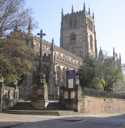For this church:    |
| ||||||||||||||||||||||||||||||||||||||||||||||||||||||||||||||||||||||||||||||||||||||||||||||||||||||||||||||||||
| Chancel windows (7 in number) | ] | in | [ | £1400 | |||
| West Window | ] | stained | [ | 1000 | |||
| North Transept Window | ] | glass | [ | 1000 | |||
| South Transept Window | ] | [ | 1000 | ||||
| The rest of the Windows re-glazed | |||||||
| In Cathedral Glass | 600 | ||||||
| -------- | |||||||
| Total | £5000 | ||||||
This was the start of the extensive stained glass we now see in St Mary’s.

In St Mary’s there are 37 stained and/or painted glass windows containing 384 lights in total.
Click the blue numbers on the key below for details of each window
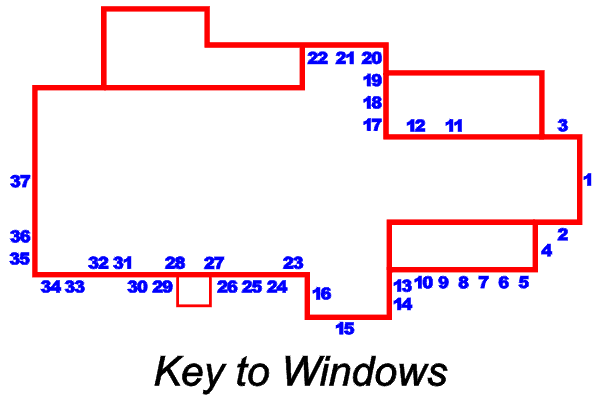
Sanctuary
1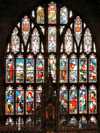 The
Great East window is the oldest Victorian stained glass window in St Mary’s
made by John
Hardman of Birmingham and installed in 1863 at a cost of £500 as
a memorial to Prince Albert the Prince Consort. This is colourful window has
36 lights, much of it hidden by the reredos.
The
Great East window is the oldest Victorian stained glass window in St Mary’s
made by John
Hardman of Birmingham and installed in 1863 at a cost of £500 as
a memorial to Prince Albert the Prince Consort. This is colourful window has
36 lights, much of it hidden by the reredos.
2 This
window of 12 lights in the chancel is dedicated to Canon
Morse and was made by Clayton and Bell in 1888. A brass plaque reads:
This
window of 12 lights in the chancel is dedicated to Canon
Morse and was made by Clayton and Bell in 1888. A brass plaque reads:
| IN HONOREM SANCTISSIMAE TRINITATIS HANC FENESTRAM FRANSISCI MORSE A.M. HUJUS ECCLESIAE PER ANNOS XXII VICARII MEMORIAE DEDICANDAM CURAVERUNT OPPIDANI PAROCHIALES AMICI OB LUCEM EVANGELII EJUS OPERA DIFFUSAM DEO GRATIAS AGENTES VITAE QUE SANCTE BENEVOLE DILIGENTER IN CHRISTO PERACTAE POSTERIS EXEMPLUM COMMENDARE STUDENTES X KAL JUL A D MDCCCLXXXVIII |
The Latin text could be (loosely) translated:
In honour of the most Holy Trinity this window to Francis Morse M.A. Vicar of this church for 22 years is dedicated in genuinely affectionate memory by occupants of the town, parishioners, friends who endeavoured to pour out the life of the church in active thanks to God for a life that was pious, kindly, diligent, completed in Christ and is commended as an example to succeeding generations 10th July 1888 AD
The window depicts scenes from the Resurrection: in the lower four lights the Resurrection itself with text: “I am the resurrection and the life he that believeth in Me though he were dead yet shall he live”; in the middle four lights the Ascension with the text “I ascend unto My Father and your Father and to My God and your God”; in the upper four lights the Day of Pentecost with the text “They were all filled with the Holy Ghost and began to speak with other tongues as the Spirit gave them utterance”.
 The
north The
northsanctuary window |
 Dedication
plaque Dedication
plaquebeneath the window |
This 12 light window was installed in 1890 and made by Edward Frampton as a memorial to G H Hebden, The dedication below the window is a mosaic inside a white and orange mottled marble frame.
The window depicts scenes from the Passion: in the lower four lights the Last Supper with text: “This is my Body which is given for you This is my Blood of the New Testament”; in the middle four lights Jesus in Gethsemane with the text “Father if it be possible let this cup pass from Me nevertheless not as I will but as Thou wilt”; in the upper four lights the arrest of Jesus with the text “And they took Jesus and led Him away and He bearing His cross went forth”.
Lady Chapel
 The
upper four The
upper fourlights of the window depicting the Day of Pentecost |
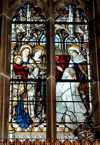 The
lower right The
lower righttwo lights, showing Katherine in a wedding dress |
The window at the east end of the Lady Chapel is a memorial to Katherine Mary Monica Wade-Dalton (née Flersheim), and consists of 12 lights depicting biblical scenes. It was installed in 1920 by Burlison and Grylls.
An inscription across the bottom two lights reads:
| To the Glory of God and in loving memory of Katherine Mary Monica wife of William Lechmere Wade-Dalton, Baptised in this Church 10th May 1899, married 23rd October 1918, died 30th October 1918 This window is dedicated by her parents CN [Caroline Hannah] and GAF [Gustav Albert Flersheim] |
Katherine, a victim of the Spanish flu epidemic, is depicted in the bottom right hand light wearing a wedding dress and veil of Nottingham lace. She is buried in Nottingham Church (Rock) Cemetery.
5 This
window is dedicated to Richard Robert Patterson and has 12 lights. It was
made by John
Hardman in 1878. The donor was Miss Patterson of The Park Nottingham.
The total cost of the window was £500 and was originally on the south
side of the chancel. The dedication in the window:
This
window is dedicated to Richard Robert Patterson and has 12 lights. It was
made by John
Hardman in 1878. The donor was Miss Patterson of The Park Nottingham.
The total cost of the window was £500 and was originally on the south
side of the chancel. The dedication in the window:
| TO THE GLORY OF GOD AND IN LOVING MEMORY OF RICHARD ROBERT PATTERSON OF THIS TOWN WHO DIED NEAR THE VICTORIA FALLS OF THE ZAMBESI RIVER SOUTH CENTRAL AFRICA SEPTEMBER 1878 A.D. ED BY HIS SISTER |
This window was moved to its present position in 1912 when the Lady Chapel was built. It was re-sited by Mr G F Gascoyne who was an artist in stained glass and had premises on Shakespeare Street, Nottingham.
 |
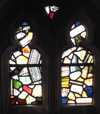 |
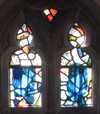 |
| Glass fragments in the three sedilia in the Lady Chapel | ||
6These 6 small lights are set in the sedilia below the Patterson window and made up of fragments of stained and coloured glass possibly installed by Mr Gascoyne when the Lady Chapel was built in 1912.
 Window
as seen Window
as seenfrom the chancel |
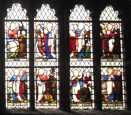 Detail
of the Detail
of thebottom four lights |
This window by Ward and Hughes was dedicated in 1868 to Sir Charles Fellows by his son Charles Francis Fellows. The window has 12 lights depicting 24 biblical scenes with text below from the New Testament. The dedication is beneath the window on a brass plaque:
| To the memory of Sir Charles Fellows Knight who died 8th November 1860 aged 61, and of Dame Elizabeth his wife who died 3rd June 1843 aged 36 dedicated by their only child Charles Francis Fellows |
This window has fragments of glass in the tracery which Pevsner states to be:
Unimportant c15 fragments in several windows of the s. chapel
This window was moved from the south chancel to its present position in 1912 by Mr G F Gascoyne of Nottingham.
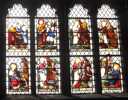 The
lowest four lights The
lowest four lightsof the Wright window |
The William Wright window by Ward and Hughes was installed in the south side of the chancel in 1868, and has 12 lights depicting 24 biblical scenes with texts below from the New Testament. The dedication on a brass plaque beneath the window reads:
| To the memory of William Wright FRCS England who died 7th January 1868 aged 74 and of Elizabeth Hall his wife who died 12th March 1855 aged 57. This window is dedicated by their seven children |
It has fragments of C15 glass in the tracery.
9This is a plain window with coloured C15 fragments in the tracery
10These 4 lights are made up of fragments of coloured glass installed at the time of the Lady Chapel.
Chancel - North side
11 This
window on the north side of the chancel is dedicated to John Watson. It was
made by Clayton and Bell in 1891and consists of 3 tiers of 4 lights, of biblical
scenes. Across the centre row is the dedication:
This
window on the north side of the chancel is dedicated to John Watson. It was
made by Clayton and Bell in 1891and consists of 3 tiers of 4 lights, of biblical
scenes. Across the centre row is the dedication:
| To the Glory of God and in loving memory of John Watson first registrar of the Diocese of Southwell and for twenty years warden of this church. Born January 30th 1830 died March 13th 1889 dedicated by his widow 1891 |
 This
window dedicated to Lord Belper was made by Clayton and Bell in 1880 and
consists of 3 tiers of 4 lights of biblical scenes and a coat of arms of
the Strutt family. At the foot of the two centre lights is the dedication:
This
window dedicated to Lord Belper was made by Clayton and Bell in 1880 and
consists of 3 tiers of 4 lights of biblical scenes and a coat of arms of
the Strutt family. At the foot of the two centre lights is the dedication:
| To the glory of God and in memory of Edward Strutt 1st Baron Belper, Lord Lieutenant of the County of Nottingham and of the town thereof. Born October 26th 1801, died 30th June 1880. Dedicated by his widow 1881 |
South Transept
bottom of the Frederick Dobson window |
The Fredrick Dobson window has 8 lights was designed by Canon Morse vicar of St Mary’s and made by Burlison and Grylls in 1882. The brass plaque beneath the window has a dedication in Latin which reads:
Ad DEI gloriam et in piam memoriam Frederici Dobson hanc fenestram
sui posuerunt. |
which translates as:
To the Glory of God and in loving memory of Fredrick Dobson, his family have placed this window. Born July 22nd 1827; fell asleep in the Lord November 7th 1882.
14This Dobson/Russell window was installed in 1903 by Burlison and Grylls and has 8 lights. In the glass is the dedication:
| To the Glory of God and in loving memory of Mary Betsy wife of Henry Russell and niece of Betsy Dorothy Dobson |
A brass plaque below the window has the dates 1857-1894.
 The
south window The
south window |
 Detail
of the Detail
of thewindow |
The Great south window was installed in 1867 and made by Heaton, Butler and Bayne has 48 lights in 4 tiers and tracery and is dedicated to Thomas Smith. Pevsner describes this window as ‘a major mid-Victorian design, as exciting as the very different early ones by Morris & Co.’ This colourful window shows the Parables of Christ. A brass inscription spanning the whole width of the transept beneath the window reads:
| In memory of Thomas Smith of Nottingham & of Gaddesley Leicestershire who died the 14th July 1699 aged 67 and was buried in this church |
Thomas Smith (1631-1699) was the founder of Smiths Bank in Nottingham.
16The Allen window on the west side of the south transept was made by Ward and Hughes in 1876 and consists of 8 lights depicting the Psalms and readings from the New Testament. The dedication in the bottom of the glass reads:
| TO THE GLORY OF GOD AND IN MEMORY OF EDWARD HENRY ONLY SON OF RICHARD AND MARY ANN ALLEN DIED OCT 26TH 1875 AGED 36 YEARS |
North Transept
17 The
Truman window was made by Clayton and Bell was installed in 1876 and has
8 lights. The dedication on a plaque, low down on the north east tower pier
reads:
The
Truman window was made by Clayton and Bell was installed in 1876 and has
8 lights. The dedication on a plaque, low down on the north east tower pier
reads:
| To the Glory of God this window is erected in loving memory of Susan Mary Truman the beloved wife of Urban Bicket Truman of this town born at Loughborough May 18th 1838 died at Nottingham March 27th 1875. In affectionate remembrance of her by her husband |
18 The
Mary Bradshaw window was made by Clayton and Bell in 1873 and consists of
8 lights depicting scenes from the Old Testament. The dedication in the glass
reads:
The
Mary Bradshaw window was made by Clayton and Bell in 1873 and consists of
8 lights depicting scenes from the Old Testament. The dedication in the glass
reads:
| To the Glory of God and in memory of Mary wife of Job Bradshaw died August 13th 1873 aged 64 erected by her husband and children |
This window was moved to its present position in 1912 by Mr. G. F. Gascoyne when the Lady Chapel was built.
19These 4 lights were installed by John Hardman as a memorial to John Featherstone in 1880. The total cost of the window was £133 5s 0d. Below the four lights are four zinc panels on which a memorial inscription has now been lost except for a few words:
died Jan 29 1855 aged 71 ... and in memory of ... died on ... Featherstone
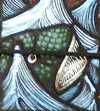 Detail
of the Detail
of thewhale! |
Clayton and Bell installed these 8 lights in 1878 as a memorial to Job Bradshaw. The right hand lower light has Jonah being thrown to the whale, the whale showing a beautiful set of teeth. The inscription on the glass reads:
| To the Glory of God and in memory of Job Bradshaw of Nottingham died 30th December 1877 aged 73 erected by his children |
Job Bradshaw (1804-1877) for 25 years was proprietor of the Nottingham Journal.
21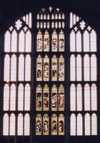 This
window, dedicated to the Revd J W Brooks,
was made by Clayton and Bell and installed in 1874. It has 48 lights but
only the centre 16 are stained glass and depict the Miracles. Inscribed in
the stained glass:
This
window, dedicated to the Revd J W Brooks,
was made by Clayton and Bell and installed in 1874. It has 48 lights but
only the centre 16 are stained glass and depict the Miracles. Inscribed in
the stained glass:
We know that thou art a teacher come from God for no man can |
22This is a plain glass window with a small number of C15 quarries with delicate patterns, some in a poor state of repair.
South Aisle
23This window of 4 lights is dedicated to the veterans of the Crimean and Indian Mutiny. It was designed by Mr Denholm Davies installed in 1936 by Hinchcliffe, Hincks and Burnell. This is the most recent window in the church. A brass plaque beneath the window reads:
| TO THE GLORY OF GOD AND IN MEMORY OF 176 VETERANS OF THE CRIMEAN WAR INDIAN MUTINY AND OTHER CAMPAIGNS WHO RESIDED IN THE CITY AND COUNTY OF NOTTINGHAM THIS WINDOW IS ERECTED BY THE NOTTINGHAM AND NOTTS. CRIMEAN AND INDIAN MUTINY VETERANS’ ASSOCIATION WHICH CARED FOR THEM IN THEIR LAST YEARS |
24 The
maker of this 6 light window is Burlison & Grylls. It was dedicated to
Frederick Story on 24th December 1922. Below
the window on a brass plaque is:
The
maker of this 6 light window is Burlison & Grylls. It was dedicated to
Frederick Story on 24th December 1922. Below
the window on a brass plaque is:
| The above window is erected to the glory of God and in loving memory of Maj:Gen: Valentine Frederick Story 11th & 38th Regts: who died 23rd April 1906, his wife Williamina who died 15th April 1917, and their daughter Mary Sophia who died 9th April 1920 |
 The Scout window The Scout window |
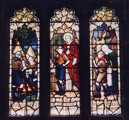 Detail
of the window Detail
of the window |
This 6 light window was erected in 1929 to the Scout Movement. The window has the signature Earnest C Carter of Hincks & Burnell, in the bottom center and a mark of a crown in bottom right hand corner. A brass plaque below the window reads:
| In thankfulness to God for the Scout Movement and its extension
throughout the world this window was presented by John Alexander Simpson District Commissioner for Nottingham in the twenty-first year after the first scout camp held on Brownsea Island |
 The Boer War The Boer Warwindow |
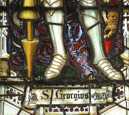 Detail
of the Detail
of thewindow |
 Dedication
plaque Dedication
plaque |
The next three windows, by Kempe & Co. are dedicated to those who served in the South African War 1899-1902 and were installed in 1905. The dedication for three windows (this one and numbers 27 and 28) is below this window on a large gilded plaque with a marble border. It lists 144 names.
27This window and window 28 are either side of the south porch and the bottom part of each window is truncated, having 3 full sized lights and 2 part lights. Bottom left, part light, an angel (with typical Kempe styling, the wings are made of peacock feathers) and holding a plaque which reads:
| All these were honoured in their generation and were the Glory of their times |
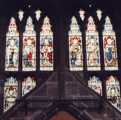 The
two windows The
two windowsstraddling the south porch |
In the smaller part-light is the Nottingham Motto: ‘VIVIT POST FUNERA VERTUS ’ (Virtue survives death)
28This window is part of the South African War memorial installed in 1905 and made by Kempe & Co. It has five lights. It belongs with windows 26 amd 27.
30 The
Fraser window installed in 1901 was made by Kempe & Co. and depicts Saints.
The dedication on a brass plaque below the window reads:
The
Fraser window installed in 1901 was made by Kempe & Co. and depicts Saints.
The dedication on a brass plaque below the window reads:
| To the Glory of God and in memory of their beloved aunt Jessie Fraser, who was born 18th Jany 1832 and died 25th March 1901, her nieces have caused this window to be here erected |
31 The
Wragg window was installed in 1920 and has 6 lights, and was made by Burlison
and Grylls. The dedication in the bottom right hand corner
of the glass reads:
The
Wragg window was installed in 1920 and has 6 lights, and was made by Burlison
and Grylls. The dedication in the bottom right hand corner
of the glass reads:
| Remember before God Charles George Wragg his wife and his parents. He died 23rd June 1910 leaving a benefaction for the erection of this window. |
32 The
Hall window was made by Burlison and Grylls in 1882. It has 6 lights showing
scenes from the Old Testament. On a wide brass plaque below is the dedication:
The
Hall window was made by Burlison and Grylls in 1882. It has 6 lights showing
scenes from the Old Testament. On a wide brass plaque below is the dedication:
| THE ABOVE WINDOW IS DEDICATED TO THE GLORY OF GOD AND TO THE MEMORY
OF HARRIETT WIFE OF JOHN HALL OBT. 22ND NOV 1822 ÆT. 23. ALSO OF SARAH, RELICT OF CAPTN. HAWKSLEY HALL H.E.I.C.S. OBT. 1834 ÆT. 64, AND HER TWO SONS, VIZ: THOMAS OBT. 1825 ÆT. 31 AND FRANCIS HAWKSLEY CAPTN. H.M. 95TH. REGT. OBT. 1832 ÆT. 39. ALSO OF FRANK B S HALL, SON OF JOHN HALL OBT. 1847 ÆT. 15, AND CHARLES GEO HALL SON OF THOMAS HALL, OBT. 1849 ÆT. 28. THE ABOVE ARE BURIED IN A VAULT WITHIN THIS CHURCH AND NEAR THIS PLACE. ALSO TO THE MEMORY OF JOHN HALL, OBT. 17TH MARCH 1881 ÆT. 84, AND ELIZABETH HIS SECOND WIFE, OBT. 1875 ÆT. 70, WHO ARE INTERRED IN THE CHURCH CEMETERY. |
33 The
Hind window was made in 1888 by Clayton and Bell and has 6 lights. In the
bottom lights is the dedication:
The
Hind window was made in 1888 by Clayton and Bell and has 6 lights. In the
bottom lights is the dedication:
| To the Glory of God and in loving memory of those gone before, this window is dedicated by Sarah and Jane R. Hind on All Saints Day 1888 |
34 The
T C Hine window was installed in 1900, made by Clayton and Bell and
has 6 lights. The dedication in the glass reads:
The
T C Hine window was installed in 1900, made by Clayton and Bell and
has 6 lights. The dedication in the glass reads:
| To the Glory of God and in loving memory of Thomas Chambers Hine FSA born 1813 died 1899 and Mary his wife born 1813 died 1893. This window is dedicated by their children |
Hine was an architect of some prominence in Nottingham, having charge of the erection of many public buildings and principle business concerns, such as the warehouse of T Adams & Co, R & T Birkin and others, the restoration of many churches, and the adaptation of the Castle for an art museum. He was also the County surveyor for Nottinghamshire.
West End
35The Kelk window made by Clayton and Bell in 1887 has 4 lights. In the glass at the bottom is the dedication:
| To the glory of God and in memory of William Kelk who died January 25 1878 aged 65 |
36The Barnett window has 4 lights was made by Clayton and Bell in 1884. In the glass is the dedication:
| To the glory of God and in memory of Sarah Barnett his faithful servant died November 26 1884 |
Miss Barnett, for some years was closely connected with the Sunday School and Guild, and generally with all the Church work,
37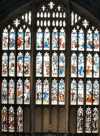 The
Great West window is in memory of Thomas Adams and was made by John
Hardman in 1876. It has 42 lights in 4 tiers and tracery. The glass for
this window cost £1094 10s. The total cost was £1400
which included transportation, the enameled brass plaque below, painting
on the wall and fitting. The dedication which is on a brass
plaque below the window, is read continuously either side of the west door
and reads as follows:
The
Great West window is in memory of Thomas Adams and was made by John
Hardman in 1876. It has 42 lights in 4 tiers and tracery. The glass for
this window cost £1094 10s. The total cost was £1400
which included transportation, the enameled brass plaque below, painting
on the wall and fitting. The dedication which is on a brass
plaque below the window, is read continuously either side of the west door
and reads as follows:
| THIS WINDOW IS DEDICATED TO THE GLORY OF GOD AND IN MEMORY OF THOMAS ADAMS MERCHANT OF THIS TOWN ANNO DOMINI MDCCCLXXVI |
Thomas Adams (1801-1873) was a lace manufacturer and merchant, and had built the large and handsome warehouse in Stoney Street, he was born in Worksop and apprenticed at Newark.
The 36 clerestory windows and all other windows in the church are of plain glass.


